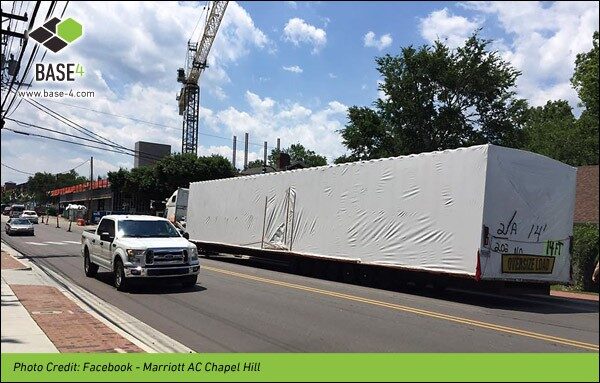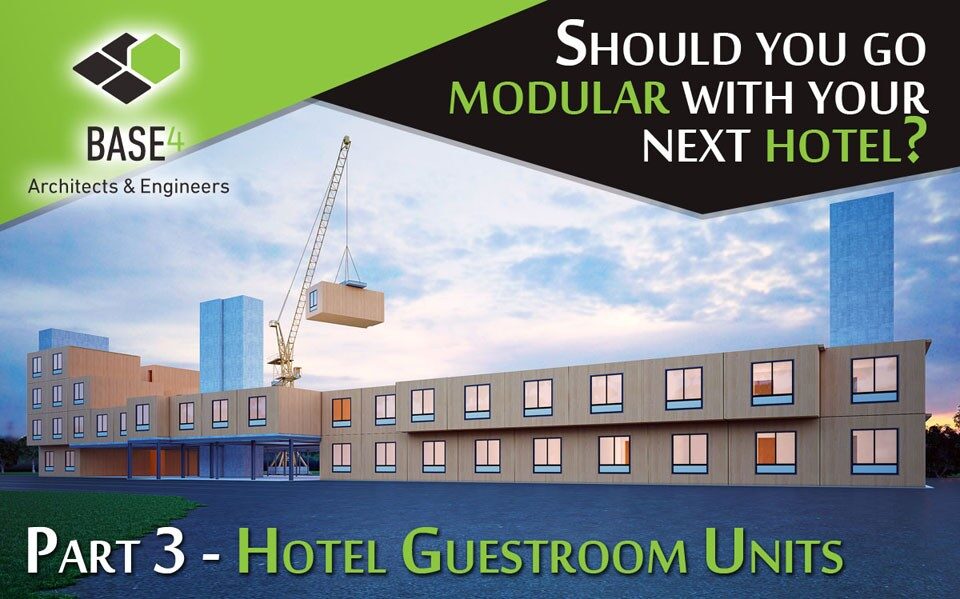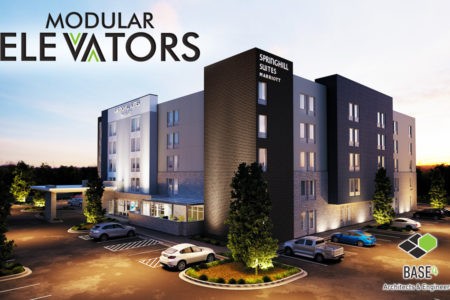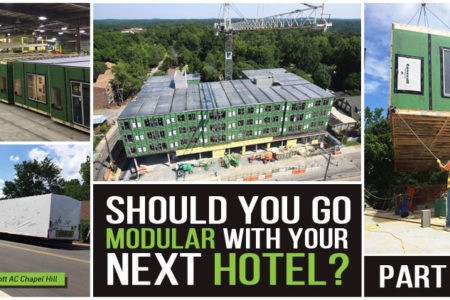Modular Construction Part III: How Can Modular Guestrooms Speed and Simplify Your Building Process?
As I discussed in previous newsletters Modular Construction & Hotel Bathroom Pods, modular is gaining new attention in the United States especially in the hotel sector. Fabricated bathroom pods are just a part of modular construction that minimizes a project punch list – fabricating entire hotel bays is another beneficiary option for modular. In this newsletter, I share the processes involved in utilizing full modular guestroom units and bays.


The Basics:
- Modular units are full hotel rooms produced off-site in a factory, a process that includes nearly completed interior work as well.
- A standard unit includes two guestrooms separated by a corridor. Other configurations, including single hotel bays, can be fabricated as well.
- Usually, modular manufacturers can design and equip individual modules with all necessary items, including everything down to the bed mattress.
- Each module is engineered independently and built to resist the rigors of transportation.
- After production and shipment, modular units arrive at the prepared site. Typically, modular units are placed on a traditionally framed ground floor steel or concrete podium structure and start at the second floor rather than directly on a slab on grade. (This allows access to the bottom of the modular units after they are set.)
- Once joined to the structure, final installation of electrical, plumbing, mechanical and structural connections occur in the corridor.
This flexible solution offers significant advantages- as well as some challenges- when compared to conventional buildings.

The Advantages:
- Reduced Construction Schedule: Modular units can be produced at the same time as the foundation and podium work is taking place at the site. As a result, modular construction can typically reduce build-time for a standard 4-5 story 100 key hotel by 3-6 months when compared to traditional construction methods.
- A High Quality of Product: A production line assembly allows for specialization. Each person on the assembly line consistently delivers high-quality products in accordance with developed standards.
- Less Disruption and Cleaner Sites: Minimal on-site construction and fabrication reduces the number of trucks, personnel and equipment and, thereby, the on-site noise, dust, and pollution. This also means less disruption to surrounding traffic due to lane closures for deliveries and reduced parking demand for on-site workers.
- Increased Sound Insulation: In modular construction, all guestrooms are separated by a double wall with a 1” air gap. This leads to higher sound ratings between guestrooms.
- Safer Work Environment: The modular construction site is a less chaotic working environment than traditional build sites because fewer workers are needed for installation and site work. A modular site also has many fewer deliveries for fixtures, finishes and equipment which means fewer boxes stacked on site which are always a concern for local fire marshals.


The Challenges:
- Team Attitude: Every project requires a great team, including GCs, Subcontractors, Designers, Owners, and City representatives. Currently, many of these project players are not accustomed and open to modular construction because of their lack of experience with it.
- Procurement: All FF&E must be delivered before the modular factory starts unit production. FF&E deliveries can take significant time so this step may hamper the project schedule if proper planning is not in place. In addition, once under construction, significant changes cannot be made to the décor packages as these items have already been purchased.
- Production Limitations: Room sizes for modular projects are limited. Due to shipping constraints, each unit cannot be more than 14 to 16 feet wide, 60 to 75 feet long, and 11-feet high. Guestroom bays for some brands are larger than this and not conducive to modular construction.
- Financing: As the factory production process is one of the main parts of the project, 60-70% of your entire construction cost is needed up front to purchase the modules. This is much different than a typical construction loan draw and many lenders will need education to this process.
- Education & Scope Issues: Since modular construction is relatively new, many GCs, suppliers, subcontractors, lenders, and city representatives will need education on how this construction type is different from a traditional project. Careful coordination between the owner/GC and these parties is important to discern everyone’s role to ensure project success.
- Inspections: While local inspectors will still be responsible for many aspects of a project (e.g. ground floor areas, guestroom corridors, etc.), the modular approach will reduce the number of local inspections required as modular units are inspected at the factory. Educating local inspectors to the fact that they don’t have jurisdiction over the guestrooms can be a delicate issue.
Many hoteliers decide on projects that fit within modular construction capabilities. For suitable projects, the benefits of using modular construction can be significant and, therefore, are becoming more and more common with leading hotels. Our next newsletter will be a FAQ on questions we see the most in modular hotel projects. If there are any, please leave your comments below or contact me at BlairH@base-4.com

Blair Hildahl
Base4 Principal
608.304.5228




